They say: “Putting the sport in sport touring.” We say: “Putting it mildly, that is.”
There, Yamaha fixed it. Happy now?
You know who you are: the guy who gets on a Yamaha FJR from riding something else. Click it into gear, head up the onramp, goose it to merge with traffic, and then commit the classic upshift-for-sixth movement that gets you nothing but pedal. Dang it. You'll do this for the first couple of days on the FJR and then you'll stop, but there are enough of you out there (and us, too) whining about having just five speeds that Yamaha did something about it.
We'd long suspected that Yamaha's reluctance to fit a sixth gear had everything to do with not wanting to totally rework the long-running inline-four. Its development costs are truly amortized, a good thing for a bike that doesn't sell 10,000 units a year. So instead of making new cases, a very expensive task, it figured out a way to put six gears in the space normally occupied by five. To start with, Yamaha changed from straight-cut to helical gears, which allows them to be narrower and handle the same torque. (Helical gears are stronger than same-sized straight gears because at any given instant there are more teeth meshing, which spreads the load.)
Next, Yamaha opted for a novel separate-dog arrangement. Normally the gear dogs, the castellated sections that slide sideways into an adjacent gear to lock a particular gear to the shaft, are part of the gears themselves. But Yamaha's solution, separating the sliding dogs from the gears, is more compact. In addition to adding a new gear, Yamaha revised pretty much every gear ratio. First and second are slightly taller (transmission ratios only), third is about the same, fourth and fifth are slightly shorter than before, and sixth is some 9 percent taller than the old fifth. In addition, Yamaha raised the final-drive gearing marginally—2.693:1 versus 2.773:1. The result is a top gear 10 percent taller than before, better spacing for performance in the top three gears, and not-really-noticeable taller initial ratios.
Yamaha wasn’t done with the drivetrain, choosing to add a slip/grip clutch, which has three coil springs in place of the one massive diaphragm it had before. On the road, this new clutch feels light and predictable, with none of the “ramp grab” we’ve felt in other slip/grip systems. Otherwise, though, Yamaha’s left well enough alone in the engine bay, though the specs show a small bump in peak torque (101.8 versus 99.1 pound-feet at 7,000 rpm) despite the fact that the FJR got two more exhaust catalysts (now four) than before. You’d never guess any of these changes from the saddle—it simply runs well.
In fact, the FJR’s whole dynamic demeanor is pleasing, from the generously torquey 1,298cc inline-four to the perfectly calibrated ride-by-wire throttle system. Indeed, while Yamaha offers both S (sport) and T (tour) ride modes, S is so smooth and predictable that you’ll probably try T once to say you did and never go back. Not only is the RBW superbly executed, so is the cruise control that it enables; Yamaha did an all-around excellent job getting the FJR to react smoothly to pretty much whatever you do.
Smooth is the operative word for riding quickly because of the FJR's softly calibrated suspension. Understand that Yamaha continues to offer two FJR models, the FJR1300A with manually adjustable suspension and the FJR1300ES with electronically adjustable legs. A few differences: This year, while the A model's suspension looks the same as before, it carries new KYB internals said to be an improvement on the YHSJ components from last year. But that's not enough to keep us from recommending you move up to the FJR-ES model because there's more range in the damping adjustments on the ES, especially as the electronics manage compression and rebound, while the manual version has adjustable rebound only. Finally, the ES offers true rear spring preload that directly influences ride height. The standard bike has a simple Hard-Soft toggle that merely locks out the softer spring when in the Hard mode. You'll begin dragging footpegs early and often in any of the softer modes, but turning the ES's rear preload all the way up (to the fourth of four settings) and commanding the damping to the Hard mode, the FJR remains more even keeled and less likely to throw sparks. At least solo with the standard hard bags carrying a modest load.
The FJR’s “gentle” suspension calibration perfectly matches its overall personality, or maybe helps set it. A riding position that’s dead-center in the sport-touring realm—one that gives your upper body a slight forward cant, but that also offers plenty of legroom and an awesomely good seat—works with really good aerodynamics for a superb high-speed experience. In 2013, Yamaha gave the FJR an updated upper fairing and an electrically operated windscreen that stays where you put it, and its range is perfect for a 5-foot-9 rider. With the shield low, there’s enough wind blast at the shoulders to keep your head in cool air; fully up, the ride is quiet and warm in cooler weather. Also so hot they’re cool: standard, extremely effective grip warmers.
Other news for the 2016 FJR is the addition of cornering lights on the ES model, while both get the full LED treatment that saves 84 watts with the high-beams going. (The charging system keeps its 590-watt output from last year.) A new Inertial Measuring Unit (IMU) informs the three LED segments in the headlight eyebrows to come on with increasing lean angle; at 7 degrees, 11 degrees, and 16 degrees, progressively. Both the cornering lights and the new LED main beams are effective, bright and well defined on the road. LED turn signals and tail light help dress up a rear end that hasn’t changed much since 2003.
Nor has the FJR's performance, which was something of a revelation in 2003 but is overshadowed by the Kawasaki Concours' extra displacement and power (The last Connie we had strapped to our dyno beat the FJR by 10 hp, and BMW's R1200RT isn't far behind the Yamaha.) But where the Yamaha shines is the way it feels all of a piece, like a machine carefully developed over a number of years. The Connie is faster and more charismatic, but a bit cruder. Bikes like Triumph's Trophy SE feel larger, more cumbersome. Only the current BMW's R1200RT seems as "right sized" as the FJR, and it is, realistically speaking, quite a bit more expensive. (Yamaha attempted to compare the new FJR to a basic R1200RT at $18,745, but those base models are unicorn-rare. Most RTs have the Premium package, which puts you at $21,300 to start.)
So is the newly six-geared FJR a revelation in sport-touring? No, but it doesn’t need to be. Instead, Yamaha built on a solid, successful platform and fixed that last of the glaring shortcomings while only marginally raising the price. It continues to be the kind of bike that will make you think of long summer days in the saddle, pointing its LED-illuminated prow at the horizon, not stopping until the 6.6-gallon tank is almost empty. With taller gearing, the FJR is more serene at realistic American highway speeds¬–at least out west, where if you’re not flirting with 80 mph most of the time, you’re going to be Peterbilt bait—and a better sport-tourer for it.
There, Yamaha fixed it. You will be happy.










/cloudfront-us-east-1.images.arcpublishing.com/octane/2BIAL2UGCCHOMJ2RZWI7C5M3OY.jpg)
/cloudfront-us-east-1.images.arcpublishing.com/octane/M7TPBMTMARBUHQEWFQPYZ42V4E.jpg)
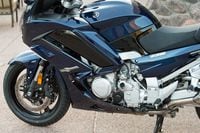

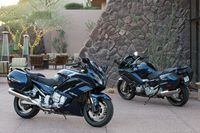
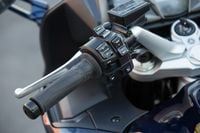
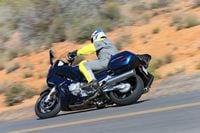
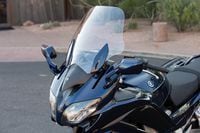
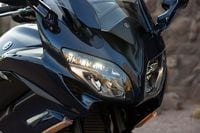




/cloudfront-us-east-1.images.arcpublishing.com/octane/JRSFLB2645FVNOQAZCKC5LNJY4.jpg)
/cloudfront-us-east-1.images.arcpublishing.com/octane/ITNLTIU5QZARHO733XP4EBTNVE.jpg)
/cloudfront-us-east-1.images.arcpublishing.com/octane/VZZXJQ6U3FESFPZCBVXKFSUG4A.jpg)
/cloudfront-us-east-1.images.arcpublishing.com/octane/QCZEPHQAMRHZPLHTDJBIJVWL3M.jpg)
/cloudfront-us-east-1.images.arcpublishing.com/octane/HXOUJXQWA5HBHGRO3EMJIGFMVI.jpg)

/cloudfront-us-east-1.images.arcpublishing.com/octane/3TIWWRV4JBBOLDVGRYECVVTA7Y.jpg)
/cloudfront-us-east-1.images.arcpublishing.com/octane/KIX5O23D5NAIBGFXBN3327DKZU.jpg)
/cloudfront-us-east-1.images.arcpublishing.com/octane/7GJYDUIPXRGMTMQKN6ONYOLBOU.jpg)
/cloudfront-us-east-1.images.arcpublishing.com/octane/MUQLOVLL2ZDGFH25ILABNBXKTI.jpg)
/cloudfront-us-east-1.images.arcpublishing.com/octane/TNOU5DNE2BC57MFPMGN2EIDXAM.jpg)
/cloudfront-us-east-1.images.arcpublishing.com/octane/GTCXACQGJ5HAPDTGWUQKDEH44E.jpg)
/cloudfront-us-east-1.images.arcpublishing.com/octane/S35YGSEMEZB4BLTDJTSZPF4GLA.jpg)
/cloudfront-us-east-1.images.arcpublishing.com/octane/5UOT6HPX2JFMRJAX6EH45AR4MQ.jpg)
/cloudfront-us-east-1.images.arcpublishing.com/octane/OKWOJWAKP5EP3OACCRRWPCIX2Q.jpg)
/cloudfront-us-east-1.images.arcpublishing.com/octane/2WF3SCE3NFBQXLDNJM7KMXA45E.jpg)
/cloudfront-us-east-1.images.arcpublishing.com/octane/G4MG6OUCJNBSHIS2MVVOTPX65E.jpg)
/cloudfront-us-east-1.images.arcpublishing.com/octane/IIGGWFOTOJGB7DB6DGBXCCMTDY.jpg)
/cloudfront-us-east-1.images.arcpublishing.com/octane/QSTCM6AVEZA5JJBUXNIQ3DSOF4.jpg)
/cloudfront-us-east-1.images.arcpublishing.com/octane/U4I7G625B5DMLF2DVIJDFZVV6M.jpg)
/cloudfront-us-east-1.images.arcpublishing.com/octane/B6XD6LS6IVCQPIU6HXDJSM3FHY.jpg)
/cloudfront-us-east-1.images.arcpublishing.com/octane/ICL63FEDDRDTTMINYICCEYGMDA.jpg)
/cloudfront-us-east-1.images.arcpublishing.com/octane/FCGZHQXRBZFLBAPC5SDIQLVF4I.jpg)
/cloudfront-us-east-1.images.arcpublishing.com/octane/WNOB6LDOIFFHJKPSVIWDYUGOPM.jpg)